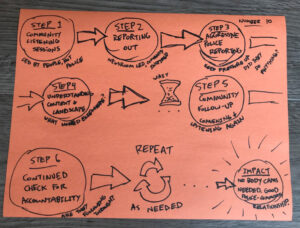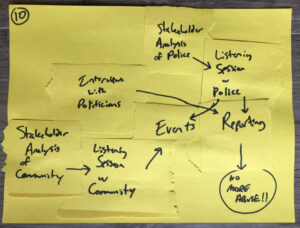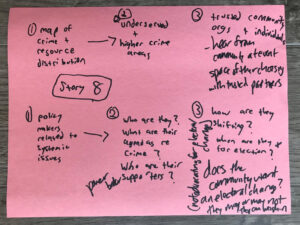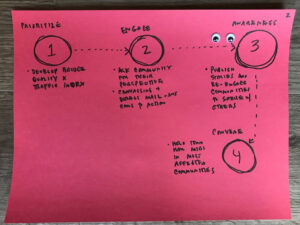
As part of the News Impact Project, we’re happy to share a few select blogs from our friends at the USC Annenberg Norman Lear Center’s Media Impact Project and guest blogger Anjanette Delgado, senior news director for digital at the Detroit Free Press.
Conferences are comfortable places to work out foreign ideas. Free from organizational and political structures back at work, people are more willing to try something new.
In July in Minneapolis, fellow journalist Jun-Kai Teoh and I ran this exercise with other journalists at SRCCON:
- Identify the opportunities for change in the story pitch.
- Imagine the challenges that will get in your way (lack of time, apathy, competing media, etc.).
- Choose which challenge — your plot twist — you’ll design around.
- Sketch your process.
SRCCON (a contraction of “Source con”) is a conference for journalists and technologists, and it’s built on the concept of active learning. Instead of panels and lectures, sessions are designed for participation and learning from each other — like when we wondered what journalists would design if we asked them to reverse engineer the story workflow for impact rather than simply publishing.
A newspaper reporter’s typical process is find story → report → write.
But what if instead it looked like this: find story → identify the opportunities for change → report // gather stakeholders // discuss // ask questions // examine the cultural framework that leads to the problem // explore solutions → design for change → impact?
Two discoveries — one surprising and both encouraging — happened when we tried this:
First, this is a very audience-first or, better yet, community-first way of approaching a story. Thinking first about what sort of impact is possible based on the story leads you to think about what’s best for the people involved and who they are. They may or may not be victims. They are definitely affected by what’s happening — whether it’s crime, education, infrastructure, whatever. There’s a ton of overlap here with engagement journalism; we designed events, listening sessions, ways of bringing people from both sides of the issue together for greater understanding.
Here’s what we heard from two of the groups:
“So we had a story about body camera use for Philadelphia police, and in many cases of police interaction with the community, there was no body camera, even if the policy put forth by the police department mandated that there should be. And so sort of the impact we were hoping for is…sort of multi-tiered, starting with making sure that the incidences of having no body camera footage goes down but also starting to address the culture inside the police department of enforcement of that rule. The rule is already there. And then also talking with the community about why that’s necessary and helping to…bridge the trust divide between the community and the police.
“And then eventually, obviously, the incidences need to go down of this police abuse and search and seizure and all that kind of stuff, which is the reason they bought the body cameras in the first place. The ultimate impact would be that it stops or goes much lower.”


– – – – – – – – – – – – – – – – – – –
“Our project had to do with Leon County’s crime rate. It’s the highest in Florida for the fifth year, despite a dip. And we thought what would be most constructive for creating change, as a result of letting the community know about this issue, is to put it into perspective and look at perception…Rather than reinforcing the perception that this place might be dangerous, and you shouldn’t go there, we can look at what is working to actually drive the crime down. Because even though the crime is highest there, it is continuing to fall. And (we can) evaluate what’s working to drive the rates down, amplify the solutions, look for opportunities for change.”

– – – – – – – – – – – – – – – – – – – –
Second, talking about the potential impact of a story with others can lead you to question the obvious, question the premise most reporters would start with. Here’s what happened when we discussed the potential impact of a story about bridges in need of repair:
“Our problem was…One in 10 bridges in Michigan were falling apart. So…bad infrastructure. And, like, we first started thinking…well, the obvious impact is…better, safer bridges. Fix the bridges. But then we were, like, wait a minute. Maybe the solution isn’t (new bridges). Maybe we don’t actually need this bridge. Maybe we need something else. Maybe if there are too many cars, and people want bike paths…We just don’t know. So we sort of paused and went ‘we don’t have the context. And so let’s figure out a way to…instead of trying to decide on what the impact is, maybe the impact is…having the community have a say in that.’ So our solution was to take what data was available about the status of the bridge and go to the local community for some of them…Start talking to those communities and say: How do you use the bridge? How do you feel about this bridge falling apart? And what would you rather have here? Do you want the big bridge fixed? Do you want a bike path? Do you want something else?…But my hope in it was: Instead of just telling the people what to think, let’s try to be a bridge for the community to say ‘this is what we want this thing to be.’”
Why is a bridge the only answer? Maybe it IS the answer, but we don’t really know until we ask.

– – – – – – – – – – – – – – – – – –
Critically, one journalist also reminded us of the unintentional impact of crime reporting:
“I think it’s just as important for us to think about that, as it is to think about intentional impact, particularly when it comes to crime stories, that can so often perpetuate stereotypes and perceptions. And I’ve been talking to a lot of community members in Oakland, California, who have told me that I avoid the news these days, because it disempowers me. It’s just about attacks on my community. And that’s the sort of impact that that sort of coverage often has on local communities.”
We’ve published the full slides from the “Designing for Impact” workshop, with sketches of every group’s intended process and comments about the red line between journalism and advocacy, here.
Kai and I would love to try this experiment again with different types of journalists. Would reporters make the same things? Would engagement journalists? Would people who have never been journalists approach this the same way or instead map out a different reporting process entirely?
Side note: I’ve discovered these two things to be true in my career, too. When I set publishing and byline goals, I falter. My message is discordant. When I instead set a goal of inspiring more journalists to consider impact in their work, my own process changes, I’m open to other strategies, I question the obvious, reach more people and end up learning far more from the great work we do together.
Impact Stories:
In this edition of impact stories, here are just some of this year’s Online Journalism Award finalists leading to change already:
- “Driver’s Notebooks Exposed Argentina’s Greatest Corruption Scandal Ever: 10 Years and Millions of Cash Bribes in Bags,” by La Nacion
- “Parkland: Unprepared and Overwhelmed,” by the South Florida Sun Sentinel
- “Case Cleared: How Rape Goes Unpunished in America,” by Newsy, ProPublica, Reveal from The Center for Investigative Reporting and PRX
- “Investigating the NRA,” by The New Yorker and The Trace
Winners will be announced Sept. 14 in New Orleans at the Online News Association’s annual conference.
Oh, and you have to love any announcement of a job promotion (congrautulations, @palewire!) that includes impact.
Anjanette Delgado is the senior news director for digital at the Detroit Free Press and freep.com, part of the USA Today Network. Twitter: @anjdelgado.
This story was originally published by the USC Annenberg Norman Lear Center’s Media Impact Project on September 6, 2019, and is republished here with permission.
